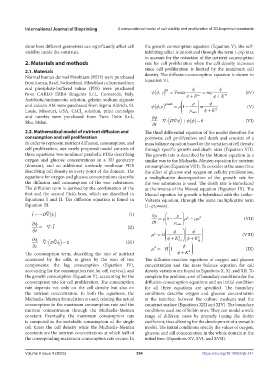Page 362 - IJB-9-4
P. 362
International Journal of Bioprinting A computational model of cell viability and proliferation of 3D-bioprinted constructs
show how different geometries can significantly affect cell the growth consumption equation (Equation V), the self-
viability inside the construct. inhibiting effect is introduced through the term 1-ρ/ρ max
to account for the reduction of the nutrient consumption
2. Materials and methods rate for cell proliferation when the cell density increases
2.1. Materials since cell proliferation is limited by the maximum cell
Normal human dermal fibroblasts (HDF) were purchased density. The diffusion-consumption equation is shown in
from Lonza, Basel, Switzerland. Fibroblast culture medium Equation VI.
and phosphate-buffered saline (PBS) were purchased lag φ φ
from CARLO ERBA Reagents S.r.l., Cornaredo, Italy. ψφ ρ, ( ) =Vmax φ + K m = m ρ φ + K m (IV)
Antibiotic/antimycotic solution, gelatin, sodium alginate
and calcein AM were purchased from Sigma Aldrich, St. ψ φρ , ( ) growth = ρ m φ (V)
ρ −1
Louis, Missouri, USA. CaCl solution, print cartridges ρ max φ + K g
2
and nozzles were purchased from Twin Helix S.r.l., ∂φ
Rho, Milan. ∂t −∇⋅( D ∇ ) + ()=φ ψ φ 0 (VI)
2.2. Mathematical model of nutrient diffusion and The third differential equation of the model describes the
consumption and cell proliferation pointwise cell proliferation and death and consists of a
In order to represent nutrient diffusion, consumption, and mass balance equation based on the variation of cell density
cell proliferation, our newly proposed model consists of through specific growth and death rates (Equation VII).
three equations: two nonlinear parabolic PDEs describing The growth rate is described by the Monod equation in a
oxygen and glucose concentrations in a 3D geometry similar way to the Michaelis–Menten equation for nutrient
(domain), and an additional unsteady nonlinear PDE consumption (Equation VIII). To consider at the same time
describing cell density in every point of the domain. The the effect of glucose and oxygen on cellular proliferation,
equations for oxygen and glucose concentrations describe a multiplicative decomposition of the growth rate for
the diffusion and consumption of the two substances. the two substances is used. The death rate is introduced
The diffusion term is derived by the combination of the as the inverse of the Monod equation (Equation IX). The
first and the second Fick’s laws, which are described in Monod equation for growth is hybridized with the Lotka–
Equations I and II. The diffusion equation is found in Volterra equation, through the same multiplicative term
Equation III. (1−ρ/ρmax).
J =− D∇() φ (I) ∂ρ = ρ 1 − ρ µ g −ρµ d (VII)
∂φ =−∇ J⋅ ∂t ρ max
∂t (II) φ φ
g
µ = G g g (VIII)
∂φ −∇ ( D⋅ ∇ ) =φ 0 (III) φ + K O φ + K
gl
2
∂t d φ
H −
µ =− 1 d (IX)
The consumption term, describing the rate of nutrient φ + K
consumed by the cells, is given by the sum of two The diffusion-reaction equations of oxygen and glucose
components: the lag consumption (Equation IV), concentration and the mass balance equation for cell
accounting for the consumption rate for cell survival, and density variation are found in Equations X, XI, and XII. To
the growth consumption (Equation V), accounting for the complete the problem, a set of boundary conditions for the
consumption rate for cell proliferation. The consumption diffusion-consumption equations and an initial condition
rate depends not only on the cell density but also on for all three equations are specified. The boundary
the nutrient concentration. In both the equations, the conditions describe oxygen and glucose concentration
Michaelis–Menten formulation is used, relating the actual at the interface between the culture medium and the
consumption to the maximum consumption rate and the construct surface (Equations XIII and XIV). The boundary
nutrient concentration through the Michaelis–Menten conditions used are of Robin ones. They can model a wide
constant. Eventually, the maximum consumption rate range of different cases by properly tuning the Robin
is computed as the metabolic consumption of the single coefficient, thus allowing for the development of a versatile
cell times the cell density while the Michaelis–Menten model. The initial conditions specify the values of oxygen,
constants are the nutrient concentrations at which half of glucose, and cell concentration in the whole domain at the
the corresponding maximum consumption rate occurs. In initial time (Equations XV, XVI, and XVII).
Volume 9 Issue 4 (2023) 354 https://doi.org/10.18063/ijb.741

